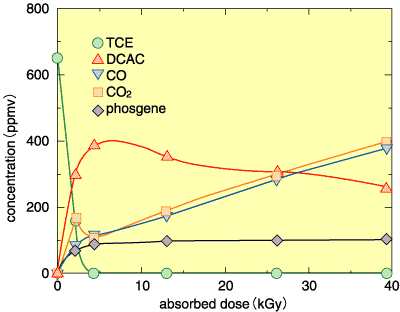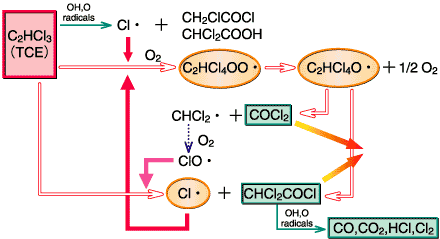Trichloroethylene (TCE) is widely used for washing and de-oiling solvents in various industries. Volatile organic compounds (VOCs) including TCE are very harmful to human health because of their carcinogenic and mutagenic effects. Pollution from TCE has caused severe problems, especially in drinking water and soil. VOCs have been treated by adsorption on activated carbon or catalytic combustion. These conventional methods can effectively and economically remove some kinds of VOCs from contaminated water and gas, when their concentrations are large. At low concentrations, however, the removal efficiency decreases. The VOCs adsorbed on the activated carbon are not converted into nontoxic compounds and there is the possibility of them becoming secondary pollution sources at places different from the original pollution.
When water or gas including VOCs are irradiated by ionizing radiation, free radicals and/or ion species produced from the base component can directly oxidize and decompose VOC molecules. Radiation-induced decompo-sition is predicted to be a new technology for the decomposition of chlorinated VOCs with low concentration at room temperature, and decomposition of TCE in water by gamma irradiation has already been applied.
Since the dose rate (dose/unit time) of electron beam irradiation is much higher compared with gamma ray irradiation, a large amount of active species are produced in a short period. Therefore, a large amount of water or air polluted with TCE can be treated within a short period. This is an especially suitable method for removing TCE from the gas phase, because of the long penetration length of electrons in the gas phase. Low energy electron accelerators can be operated with simple X-ray shielding systems and without a skillful operator. The process will be more commercial then one by using a low energy accelerator. As a result of these experiments, the important chain reaction in the decomposition mechanism of TCE in an electron beam has been revealed. |

